Related Research Articles

Lucerne or Luzern is a city in central Switzerland, in the German-speaking portion of the country. Lucerne is the capital of the canton of Lucerne and part of the district of the same name. With a population of approximately 82,000 people, Lucerne is the most populous city in Central Switzerland, and a nexus of economics, transportation, culture, and media in the region. The city's urban area consists of 19 municipalities and towns with an overall population of about 220,000 people.
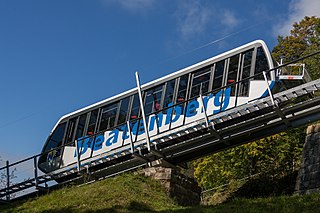
The Thunersee–Beatenberg Funicular is a funicular in the Swiss Canton of Berne. It links a jetty, at Beatenbucht in the municipality of Sigriswil and on the shores of Lake Thun, to the village of Beatenberg, situated on the plateau above at 1,120 metres (3,675 ft) above sea level.
Hermann von Liebenau was a Swiss historian.

The Bürgenstock Funicular is a funicular railway in the canton of Nidwalden, Switzerland. The line links the landing stage at Kehrsiten-Bürgenstock, served by the regular passenger boats of the Schifffahrtsgesellschaft des Vierwaldstättersees, with the Bürgenstock resort and its famous hotels.

The St. Moritz–Corviglia Funicular is a funicular railway in the canton of Graubünden, Switzerland. The line links the town of St. Moritz at 1848 m with the Corviglia summit and ski area at 2489 m, and comprises two sections of differing gauge, with passengers changing cars at the intermediate station of Chantarella.
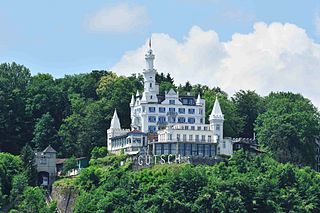
The Gütsch Funicular, also known as the Drahtseilbahn Gütsch (DBG) or simply the Gütschbahn, is a funicular railway in the city of Lucerne in the Swiss canton of Lucerne. The line links a lower station located on Baselstrasse, some 1 kilometre (0.62 mi) west of the centre of the city, with an upper station adjacent to the Château Gütsch hotel, 90 m above.
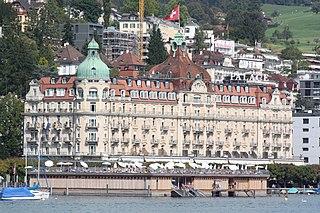
The Mandarin Oriental Palace, Luzern is a grand hotel of the Belle Époque, located on the north shore of the lake on "National Quai" ("Nationalquai") in Lucerne, Switzerland. It was built as the Palace Hotel Luzern between 1904 and 1906, and is officially designated as a cultural asset of national importance.
Franz Josef Bucher was a Swiss hotels pioneer and magnate.
Renward Cysat was an apothecary, advocate, cartographer and city councillor of Lucerne. He is the father of mathematician and astronomer Johann Baptist Cysat.

SHL Schweizerische Hotelfachschule Luzern is the partner for applied hospitality management education with national and international recognition. Founded in 1909, SHL is a leading professional-oriented hotel management institution in Lucerne, Switzerland.

The Bernese Jura Railway was a railway company in Switzerland. The company was called the Jura–Bern–Luzern from 1 July 1884. The Jura–Bern–Lucerne merged with the Western Switzerland–Simplon Railways to form the Jura–Simplon Railway (Jura-Simplon-Bahn), JS) on 1 January 1890.
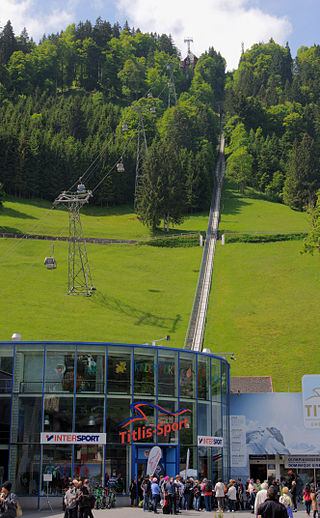
Gerschnialpbahn is a funicular railway in Obwalden, Switzerland. The line leads from Engelberg at 1000 m to Gerschnialp at 1262 m on the slopes of Titlis. The funicular with two cars has a single track with a passing loop and a tunnel at upper end. Journey time is 5 minutes. It operates all year.

Schatzalp-Bahn is a funicular railway in Davos, Switzerland. The line leads from Davos-Platz at 1557 m to Schatzalp at 1861 m. It has a length of 712 m at a maximum inclination of 47% with a difference of elevation of 304 m. The funicular with two cars has a single track with a passing loop. It provides access to Schatzalp and Strela skiing area.

Muottas-Muragl-Bahn is a funicular railway in Engadin, Switzerland. The line leads from Punt Murgal near Samedan at 1740 m to Muottas Muragl at 2445 m near its summit. The funicular with two cars has a single track with a passing loop. The line of 2170 m in length has a difference of elevation of 705 m at a maximum inclination of 54%.
Dietschibergbahn was a funicular railway at Lucerne, Switzerland. The line lead from the city to Dietschiberg at 628 m. The hill, 210 m above Lake Lucerne, was also known as "Little Rigi". The line had length of 1240 m and an incline between 9 and 25%. The funicular with two cars had a single track with a passing loop.

Wartensteinbahn was a funicular railway in the canton of St. Gallen, Switzerland. The line led from Bad Ragaz at 520 m to Wartenstein at 747 m. It was built in 1892 for tourists in the resort Ragaz to access the viewpoint and restaurant at Wartenstein. The line with a length of 790 m had a difference of elevation of 206 m at a maximum incline of 30%. The single-track line with a passing loop used water counterbalancing.

Fürigenbahn was a funicular railway above Lake Lucerne at Stansstad, Nidwalden, Switzerland. The line led from the bath in Harissenbucht, a bay of Lake Lucerne, at 437 m to the Hotel Fürigen at 639 m. The track had a length of 375 m with a difference of elevation of 202 m and a maximum incline of 73%. The hotel built it for clients' use in spring 1924, but opened it to the public in 1927, after the Swiss Federal Assembly granted a concession for 80 years.

Drahtseilbahn Engelberg-Hotel Terrasse was a funicular railway in Engelberg, Switzerland. It led from the resort Engelberg at 1003 m to Hotel Terrace at 1053 m. The two-car line with passing loop had a length of 136 m and a maximum incline of 37.2%. It was one of the funiculars built at Belle Epoque hotels.
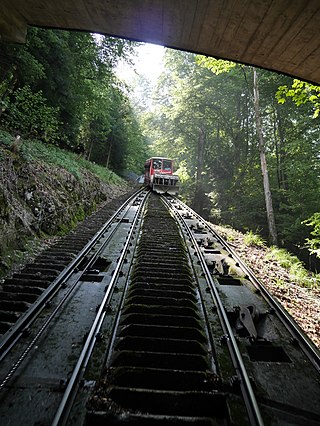
Drahtseilbahn Schwyz–Stoos was a funicular railway in the canton of Schwyz, Switzerland. It led from Schlattli in the municipality of Schwyz at 569 m to Stoos at 1294 m. The funicular was in use from 1933 to 2017, when it had been replaced by the current Stoosbahn with a different route.
References
- 1 2 Coulin, Jules (28 July 1911), "Hotel Montana in Luzern", Die Schweizerische Baukunst (in German), 3 (15): 201–208,
dann führt eine elektrische Bahn die Gäste in einer Minute von der Haldenstrasse (hinter Quai National) ins Vestibühl. Der kleine Bahnhof nächst dem Palacehotel hat schwere und ernste Formen, wie um besonders deutlich den Unterschied zu seiner Umgebung zu betonen. Der kommende bildnerische Schmuck wird das strenge Aeussere des kleinen Aufnahmegebäudes noch beleben.
- 1 2 3 "6000.02 Luzern Gesegnetmattstr. 1 - Hotel Montana", Standseilbahn.ch (in German)
- 1 2 "Drahtseilbahn Hotel Montana", Funimag
- 1 2 Swiss Federal Council (24 December 1913), "Botschaft des Bundesrates an die Bundesversammlung betreffend Konzession einer elektrischen Drahtseilbahn von der Haldenstrasse in Luzern nach dem Hotel Montana. (Vom 18. Dezember 1913.)" (PDF), Bundesblatt (in German), 1913/5 (51): 357–364, BAR-ADS: 10025219